In the dynamic landscape of modern software development, effective communication and teamwork are paramount. Picture yourself immersed in a software project, with the need to maintain constant team updates throughout the development journey.
This is precisely where the synergy between Slack, the renowned messaging platform, and Jenkins, the automation juggernaut, takes center stage. By integrating Slack with Jenkins, you unlock the potential for receiving real-time notifications and progress reports all in one consolidated hub.
In this article, we’ll delve into the harmonious fusion of these two tools, promising to elevate your software development process into a more efficient and enjoyable experience. Let’s embark on this enlightening journey!
STEPS:
Step 1: Create a Slack account
Step 2: Launch an ec2 instance and install Jenkins on it.
Step 3: Install the Jenkins CI app on Slack
Step 4: Install the Splunk Notification Plugin on Jenkins
Step 5: Run a Sample test
Create a Slack account
Open your preferred web browser (e.g., Google Chrome, Mozilla Firefox, Safari, or Microsoft Edge).
In the address bar, type or click on the following URL to access Slack’s official website: https://slack.com
On the Slack homepage, you’ll find a prominent “SIGN UP WITH GOOGLE” or “Try for Free” button. Click on it.

- Select your mail here to create an Account

Sometimes it may ask for the password of your mail, or it will move to the next page
confirm your mail
Now click on Create a Workspace.
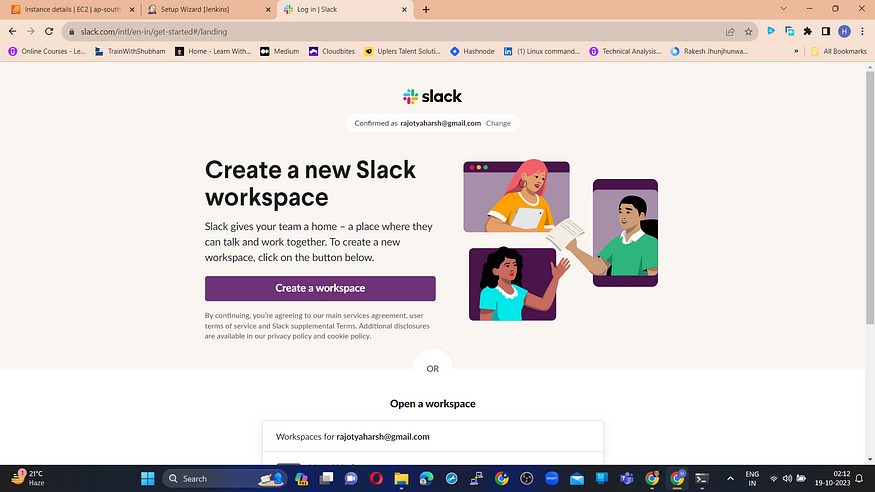
- Provide a name for your Slack and click next

- Next, provide your name that helps your teammates recognise and add a profile photo
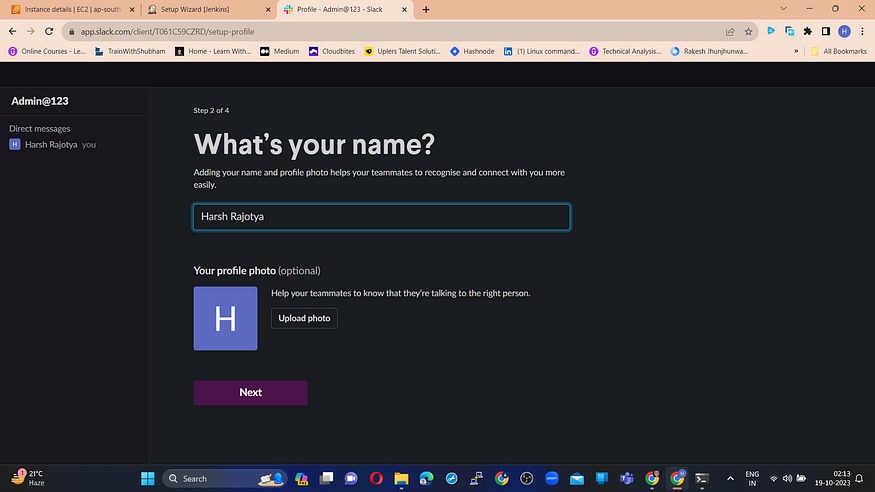
- If you want to add your friends to the Slack channel provide their email or send an invitation. otherwise, skip

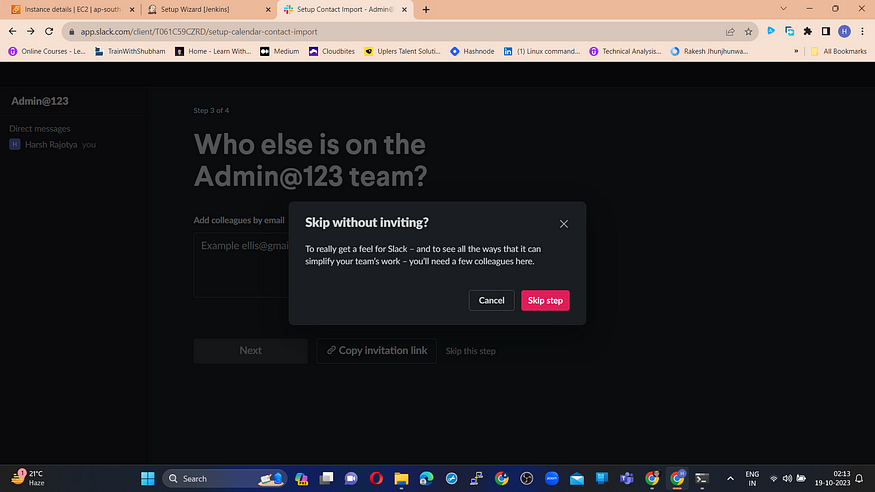
- We are using Slack for Jenkins right that’s why I provided the name Jenkins and clicked on the next

- Now Slack created a channel named Jenkins and clicked Let’s Go.

- Your Slack account has been created. Now you can send messages

Launch Ec2 Instance with Jenkins
- Launch an Ubuntu ec2 instance in the AWS console and use the below user data to install Jenkins on it
#!/bin/bash
# Update the package list
sudo apt update -y
# Add Adoptium repository key
wget -O - https://packages.adoptium.net/artifactory/api/gpg/key/public | sudo tee /usr/share/keyrings/adoptium-archive-keyring.gpg > /dev/null
# Add Adoptium repository to sources list
echo "deb [signed-by=/usr/share/keyrings/adoptium-archive-keyring.gpg] https://packages.adoptium.net/artifactory/deb $(awk -F= '/^VERSION_CODENAME/{print$2}' /etc/os-release) main" | sudo tee /etc/apt/sources.list.d/adoptium.list
# Update package list again
sudo apt update -y
# Install Temurin (formerly AdoptOpenJDK) 17 JDK
sudo apt install temurin-17-jdk -y
# Check Java version
/usr/bin/java --version
# Add Jenkins repository key
curl -fsSL https://pkg.jenkins.io/debian-stable/jenkins.io.key | sudo gpg --dearmor -o /usr/share/keyrings/jenkins-archive-keyring.gpg
# Add Jenkins repository to sources list
echo "deb [signed-by=/usr/share/keyrings/jenkins-archive-keyring.gpg] https://pkg.jenkins.io/debian-stable binary/" | sudo tee /etc/apt/sources.list.d/jenkins.list
# Update package list
sudo apt update -y
# Install Jenkins
sudo apt-get install jenkins -y
# Start Jenkins service
sudo systemctl start jenkins
# Check Jenkins service status
sudo systemctl status jenkins
# Display the initialAdminPassword
sudo cat /var/lib/jenkins/secrets/initialAdminPassword
- This will install Jenkins on it. and install suggested plugins and create a user for Jenkins.
Install the Jenkins CI app on Slack
Go to Slack and click on your name
Select Settings and Administration
Click on Manage apps
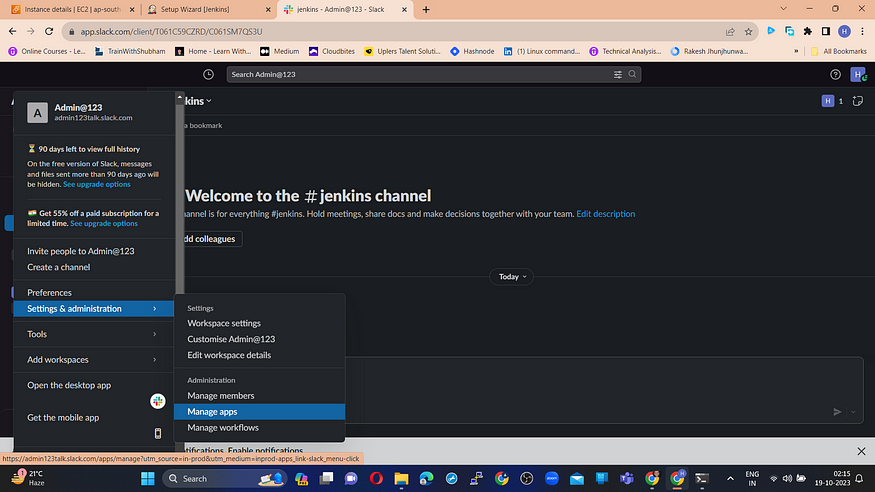
It will open a new tab
Search for Jenkins CI and click on it
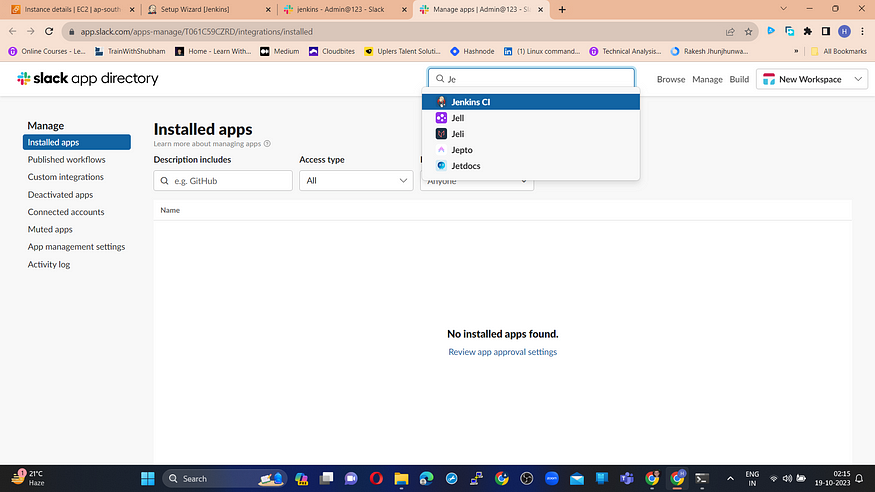
It will open another tab
Click on Add to Slack
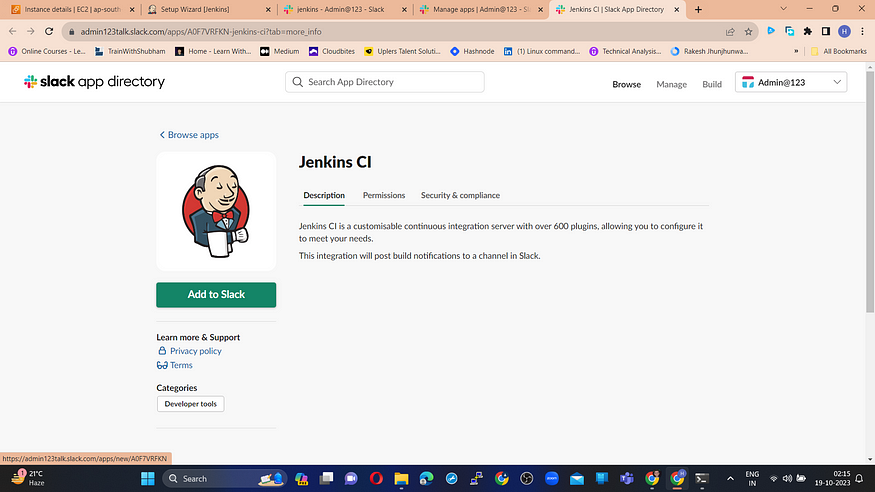
Now choose your Slack channel
Click on Add Jenkins CI integration.

- You will be redirected to this page

- Copy the team subdomain and integration token credential ID for later use.


Install Slack Notification Plugin in Jenkins
Go to Jenkins Dashboard
Click on manage Jenkins → Plugins → Available plugins
Search for Slack Notification and install
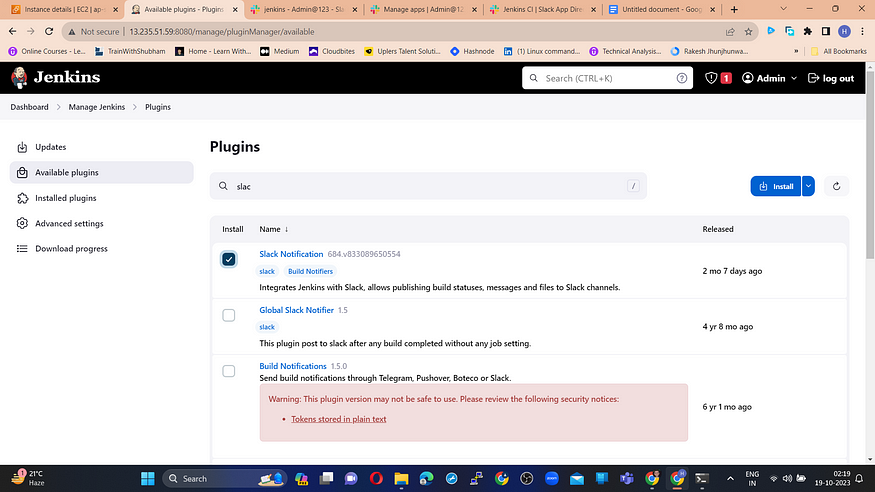
Click on Manage Jenkins → Credentials → Global
Select kind as Secret Text
At Secret Section Provide Your Slack integration token credential ID
Id and description are optional and create

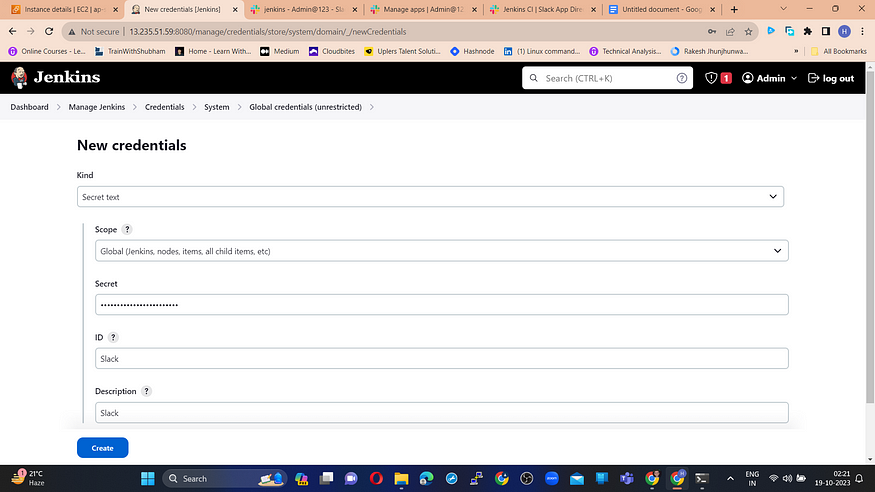
Click on Manage Jenkins → System
Go to the end of the page
Workspace → team subdomain
Credential → Select your Credential for Slack
Default channel → Provide your Channel name
Test connection


Click on Apply and save
Now Go to Jenkins Dashboard click on New item or create a Pipeline job
and add this pipeline
def COLOR_MAP = [
'FAILURE' : 'danger',
'SUCCESS' : 'good'
]
pipeline {
agent any
stages {
stage('Hello') {
steps {
echo "Hello world"
}
}
}
post {
always {
script {
def slackColor = COLOR_MAP[currentBuild.currentResult] ?: 'warning' // Default to 'warning' if the result is not explicitly defined
echo 'Sending Slack Notifications'
slackSend(
channel: '#channel-name', // Change your channel name
color: slackColor,
message: """
*${currentBuild.currentResult}:* Job ${env.JOB_NAME}
build ${env.BUILD_NUMBER}
More info at: ${env.BUILD_URL}
"""
)
}
}
}
}
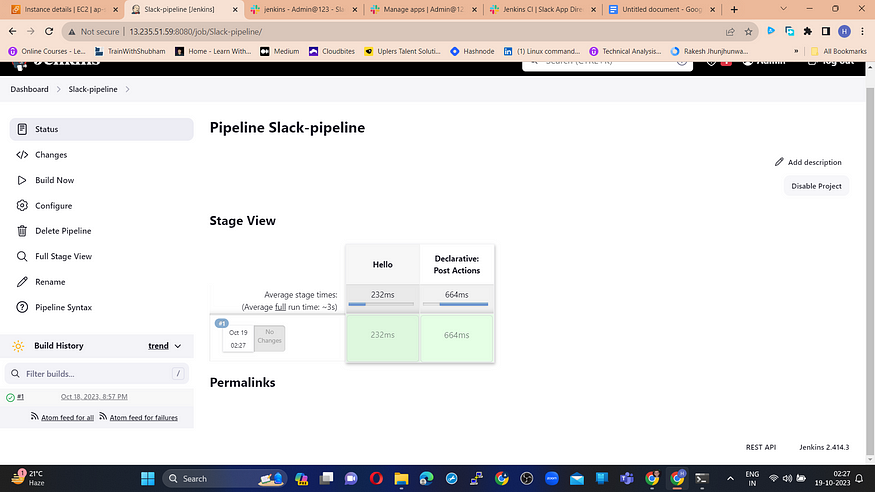

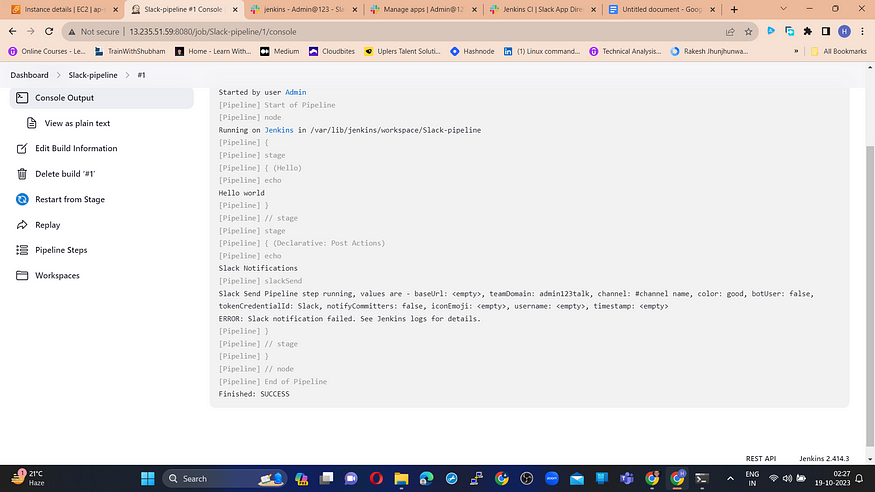
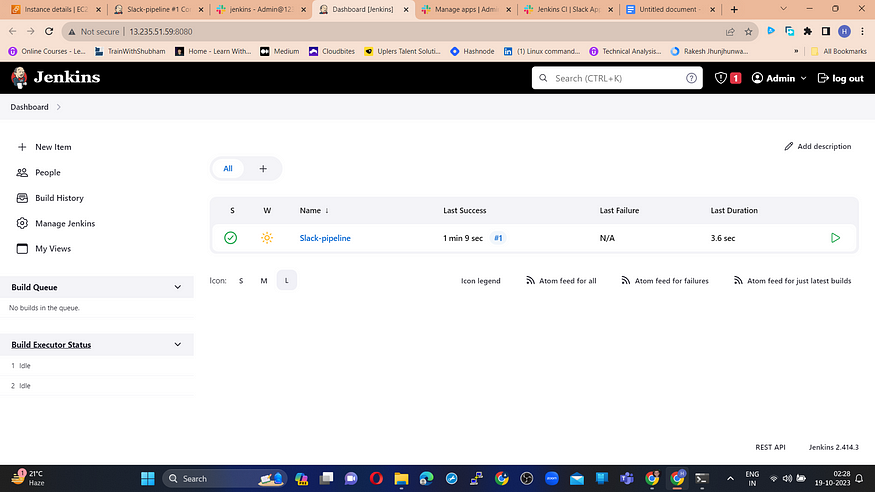

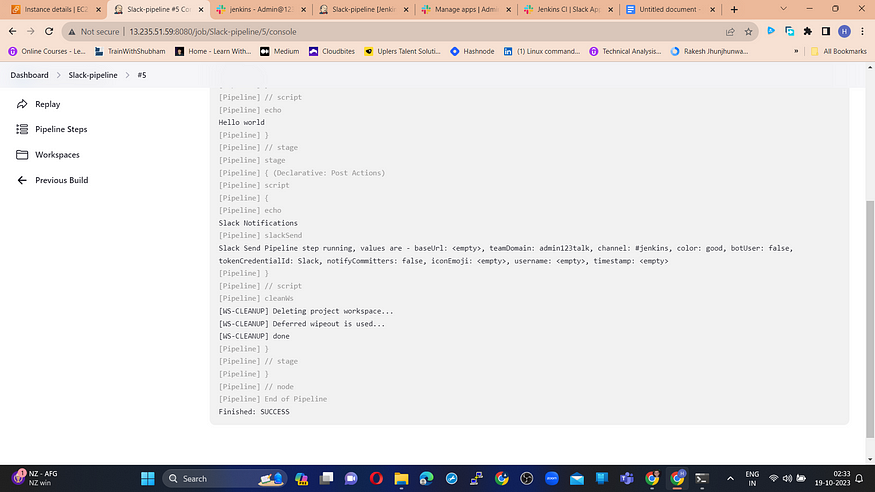
- You will get a Notification in Slack

Slack and Jenkins, each a formidable asset in your DevOps arsenal, can unleash their full potential when they collaborate. Together, they open up a realm of limitless possibilities, providing real-time notifications, streamlining communication, and fostering seamless teamwork. This union isn’t just a connection; it’s a bridge that seamlessly melds the worlds of messaging and automation.
Your feedback is instrumental to our growth, so please feel free to reach out to me on LinkedIn at Mudit Mathur (https://www.linkedin.com/in/mudit--mathur/). Stay tuned for a continuous stream of invaluable DevOps insights, along with an ever-evolving treasure trove of tips and tricks. As we journey forward, your support and curiosity are deeply appreciated.
Thank you for being a part of my blog’s readership.